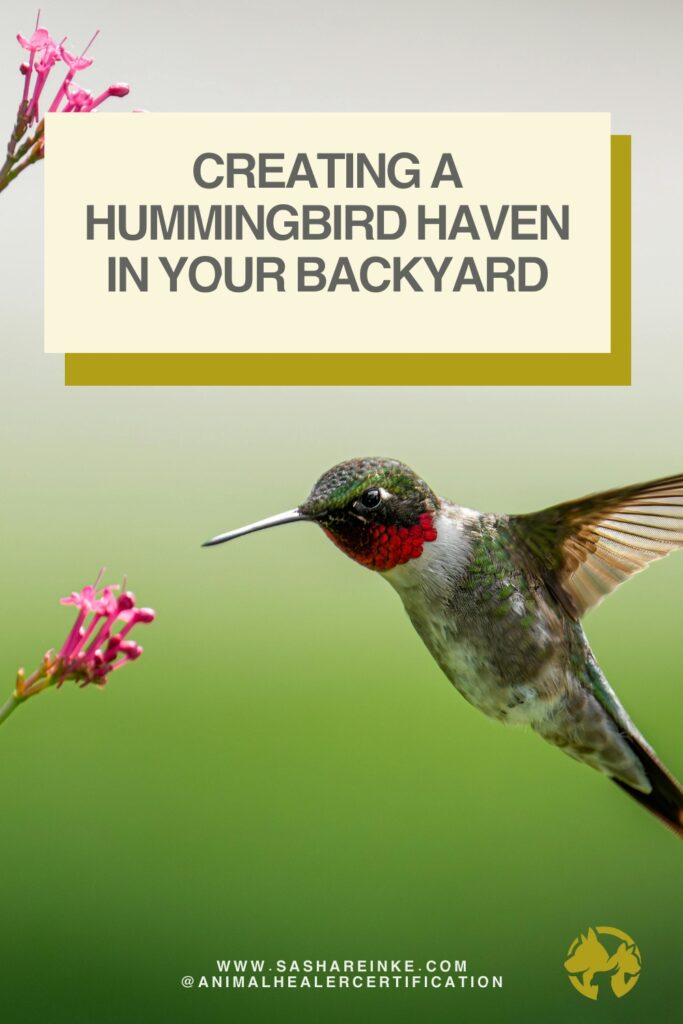Hi, I’m Sasha and I teach animal lovers how to work with and start their own pet business from the comfort of their own home.
Imagine stepping into your backyard and being greeted by the vibrant flutter of hummingbirds, their iridescent feathers catching the sunlight as they hover gracefully. These tiny creatures are more than just a delight to watch; they are symbols of joy, healing, and good fortune. By transforming your outdoor space into a hummingbird haven, you not only support local wildlife but also invite positive energy and spiritual harmony into your life.
The Spiritual Significance of Hummingbirds
In various cultures, hummingbirds are revered as messengers of hope and healers of the soul. Their presence is often associated with:
Joy and Lightness: Hummingbirds remind us to savor the sweetness of life and to approach each day with a light heart.
Resilience and Adaptability: Despite their delicate appearance, hummingbirds are incredibly resilient, symbolizing the ability to overcome challenges.
Spiritual Connection: Their swift movements and hovering abilities are seen as a bridge between the physical and spiritual realms, encouraging us to stay present and connected to our inner selves.
Designing Your Hummingbird Sanctuary
Creating a space that attracts hummingbirds involves thoughtful planning and a touch of creativity. Here’s how you can craft a sanctuary that appeals to these enchanting birds:
1. Select the Right Plants
Hummingbirds are drawn to brightly colored, tubular flowers rich in nectar. Incorporate a variety of native plants that bloom at different times to provide a consistent food source:
Bee Balm (Monarda): Vibrant and aromatic, it’s a hummingbird favorite.
Trumpet Vine (Campsis radicans): Its large, trumpet-shaped flowers are perfect for their long beaks.
Salvia (Salvia spp.): Offers abundant nectar and comes in various colors.
Columbine (Aquilegia canadensis): Early bloomers that provide nectar in spring.
Plant these in clusters to create a more noticeable target for hummingbirds.
2. Install Hummingbird Feeders
Supplement natural nectar sources with feeders:
Choose Red Feeders: The color red attracts hummingbirds. Opt for feeders with red accents but avoid using red dye in the nectar.
Use the Right Nectar Recipe: Mix 1 part white granulated sugar with 4 parts water. Boil the mixture, let it cool, and fill the feeder.
Placement: Hang feeders in shaded areas near plants, about 10-15 feet from cover to provide safety from predators.
Maintenance: Clean feeders every 3-5 days with hot water to prevent mold and fermentation.
3. Provide Water Sources
Hummingbirds need water for drinking and bathing:
Birdbaths: Use shallow birdbaths with sloping sides. Add flat stones for perching.
Misters and Drippers: These mimic natural water sources and are particularly attractive to hummingbirds.
4. Avoid Pesticides
Chemicals can harm hummingbirds and reduce their food sources. Embrace organic gardening practices to create a safe environment.
Enhancing the Spiritual Connection
Engaging with hummingbirds can be a meditative and spiritually enriching experience:
Mindful Observation: Spend time quietly watching their behavior, allowing yourself to be present in the moment.
Journaling: Reflect on the emotions and thoughts that arise during your interactions with hummingbirds.
Symbolic Decor: Incorporate hummingbird imagery in your garden to reinforce their symbolic presence.
By creating a hummingbird-friendly environment, you not only contribute to the well-being of these remarkable birds but also invite a sense of joy, resilience, and spiritual connection into your life. Let your garden be a sanctuary for both hummingbirds and your soul.




